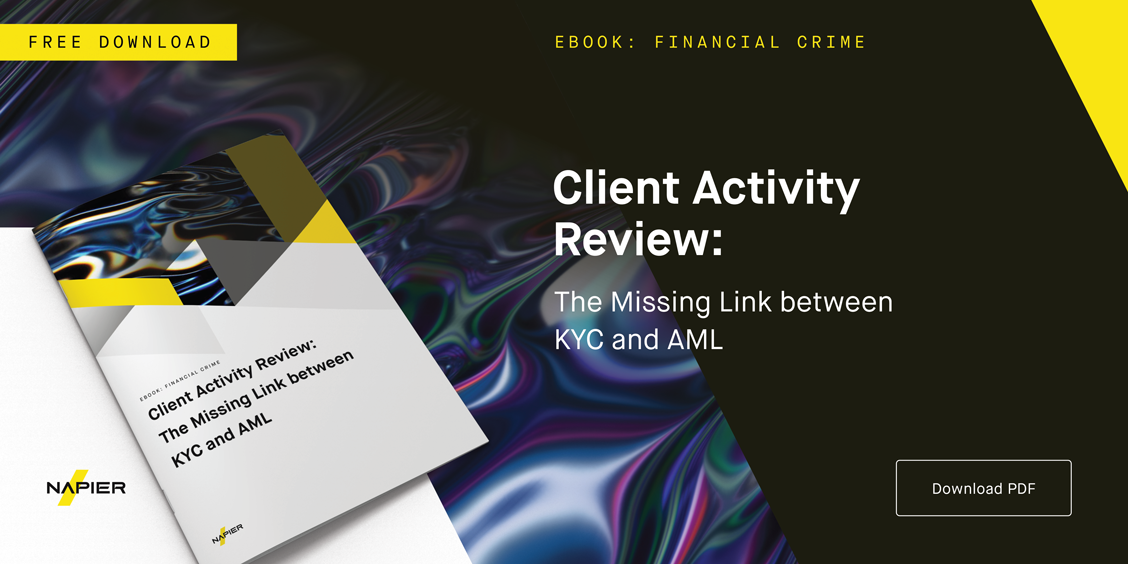In last week’s blog, we examined the obstacles encountered by financial institutions in fighting financial crime. We discussed the challenges presented by process-driven AML and the dangers of the silo effect. This week, we will explore customer-centricity, and explain why understanding customer behaviour is so important.
Customer-centricity is key. So is understanding customer behaviour
Ongoing monitoring and the financial regulator
The financial crime guide issued by the UK’s Financial Conduct Authority (FCA) is emphatic in its directive to firms:
“A firm must conduct ongoing monitoring of its business relationships on a risk-sensitive basis. Ongoing monitoring means scrutinizing transactions to ensure that they are consistent with what the firm knows about the customer and taking steps to ensure that the firm’s knowledge about the business relationship remains current.”
This mandate is common to most financial regulatory bodies.
Firms are obliged to implement the ongoing review of customers and assess all clients’ activities and behaviours over time. At its core, this means firms must be able to consolidate different sets of customer-related data into an AML tool which is both holistic of and unique to each client.
Ongoing monitoring and customer-centricity
The 360° ‘single view of the customer’ encapsulates the entire lifecycle of each individual client, rather than taking singular snapshots using the periodic KYC approach we too often see.
By amalgamating the many, fragmented customer data sets into this ‘single view’, regulated firms can create a complete record of each client’s accounts across lines of business, geographies, and products. These firms can then use that data more productively and efficiently to combat money laundering, tax evasion and serious financial crime.
Using customer behavioural analytics to fight financial crime
Financial firms seeking to achieve AML compliance and perpetual KYC are increasingly employing customer behavioural analytics. As we have discussed in previous blogs, financial criminality evolves and adapts rapidly, and the financial sector is not keeping up. The use of traditional rule-based transaction monitoring systems is still pervasive, and without a full view of the customer behaviour, firms are less effective at accurately and sustainably identifying new patterns of suspicious activity.
Rules, red flags, and financial crime
Rule-based systems are typically based on red flags - thresholds developed from patterns of activity that indicate known financial crime typologies. These are then applied to transaction data. Two problems arise here:
- The first is that transaction data alone gives a relatively small number of data attributes to work with, which are often either not populated or incorrect due to data quality issues;
- The second problem is that using only red flags and rules on these data sets makes it hard to distinguish between what is legitimate and what is not from a behavioural perspective.
An example of how these problems combine to impede AML compliance is well-known to New York Stock Exchange (NYSE) traders:
New York’s ‘witching hour’
In the USA, the last hour of trading on the NYSE on the third Fridays during each of the months of March, June, September and December is known as the ‘triple witching hour’. This refers to the quarterly expiry of three option classes- stock options, index futures and stock index options-on the same day four times per year. Predictably, this causes a spike in trading volumes and therefore payment activity, which can be volatile.
Financial criminals hide in plain sight
For financial criminals, this is the ideal opportunity to hide criminal activity in plain sight because there is so much cash in the market. However, rules-based systems may not be able to detect this as the payment activity may appear to be legitimate - they are unable to factor in how humans might behave in response to certain events. Customer behaviour analytics, however, does provide these sorts of insights. This can assist in identifying suspicious activity more accurately. It works like this:
- Create a 360-degree view by bringing together customer identities, associations, transaction patterns and behaviours across the organization;
- Use that data to compare the customer’s current behaviour with that over their entire relationship with the organization;
- Compare that customer’s behaviour to other similar customers (segmented according to similar profiles e.g. similar industries for corporate customers or similar age ranges for individuals);
- Compare that customer’s behaviour to all other customers.
Steps 2-4 allow anomalous behaviour to be identified and investigated further, even if rules-based alerts have not been triggered.
Many different types of behaviour can be identified in this manner - unusual times of the day for transactions, unusual counterparties, use of atypical currencies etc. none of which may be caught by existing red flags.
As well as the increased likelihood of detecting suspicious activity, the other key benefit of customer behavioural analytics is that it is much harder for financial criminals to evade. Well-known red flags and the rules used to trigger them are easy to game - detection of anomalous behaviour, much less so.
Understanding your customer and Napier’s Client Activity Review
The holistic AML approach represents the future of both fighting money laundering and the countering of financing of terrorism (CFT). We can now see the critical role which customer-centricity plays in successfully fighting financial crime.
Next week, Napier will introduce its unique Client Activity Review (CAR), and describe how our innovative tool will enable you to truly understand - not merely know - your customer.
This article is an extract from our larger paper on the importance of a holistic approach to AML. If you would like read more about the benefits of a holistic approach to AML, download Understand your customer: The importance of a holistic view of client activity in AML.

Find out how to improve your AML processes with award winning technology.
Get in touch to see how our intelligent compliance solution can help your organisation or request a demo to see it in action.


.svg)
























